
Wine Culture and Information since 2002 - Volume 22
 Wine Culture and Information since 2002 - Volume 22 |
|
Contrasts of Gavi and Sannio FalanghinaCortese and Falanghina compared in the glasses of this month's tasting by contrast. Two grapes capable of making extraordinary wines, primary glories of the enology in the provinces of Alessandria and Benevento. |
|
The production of white wines is not exactly simple and, while the making of other styles of wines in not simple as well, producing a high quality white wine is certainly more complex and difficult than other types. Reiterating that, in any case, making quality wine is a difficult task, whites add the further difficulty of being a product subject to even more critical factors and such as to compromise their finesse and quality. This, of course, according to the style and type of wine to be produced, not least the grapes used for its production and the agronomic and enological practices adopted to achieve a specific result. Among the critical factors that can compromise the production of a white wine – except in cases when this is a desired quality – is the effect of oxygen, capable of altering every organoleptic aspect of a white wine. Oxygen, in fact, in addition to making the color of a white wine “darker”, also flattens its olfactory profile, increasing – at the same time – the gustatory roundness at the expense of crispness, giving, on the whole, a not elegant and decidedly ordinary white wine. Of course, the wines that we will pour into the glasses of this month's tasting by contrast are no exception: Gavi and Sannio Falanghina. These two whites are among the protagonists of the enology of their provinces – Alessandria and Benevento, respectively – capable of expressing finesse and quality, albeit in different ways and characters. At the base of these two interesting wines we have Cortese, as far as Gavi is concerned, and Falanghina for the white produced in the large territory of Sannio, in the province of Benevento, Campania. These two varieties have a long history and are also found in other territories, not only in those of their respective regions of origin. In both cases, they are wines of absolute finesse and elegance, produced – in their respective territories – in different styles and all being absolutely interesting. These two grapes, in fact, have excellent enological versatility, from dry whites to late harvest ones, from sparkling to sweet wines made from dried grapes. Interesting results are also obtained with the aging in wood, a technique however allowing to preserve the specific organoleptic qualities of the two grapes.
|
|
Gavi is a white wine from Piedmont, notoriously a land of reds, which production area is recognized by the Italian quality system as Denominazione d'Origine Controllata e Garantita (Denomination of Controlled and Guaranteed Origin, DOCG). It is – by considering the enological vocation of its region – a decidedly rare and unique wine, as in Piedmont, with some exceptions, the vineyards are mostly colored with red grapes. Gavi – or Cortese di Gavi – is an important protagonist of the province of Alessandria and boasts an ancient and significant history. The first official mention of Gavi wine dates back to 1659, mentioned in a letter addressed to the Marquis Doria. Gavi is the name of the town in the province of Alessandria from which the wine takes its name and which, in turn – so the legend goes – is named after the beautiful princess Gavia, daughter of Chlodomer, king of francs. In 528, the story goes, the princess settled in these lands – through the Pope's intercession – in an attempt to escape the troops of King Chlodomer, for the fact she got married in secret and against the consent of her father, with a young man, a page of the court. Even the grape used for the production of Gavi – Cortese – seems to owe its name to Princess Gavia, as a tribute to her beauty and courtesy. Gavi is today a wine with a Denomination of Controlled and Guaranteed Origin (DOCG) and is produced in eleven municipalities in the province of Alessandria, exclusively with Cortese grapes. This wine, which can also be called “Cortese di Gavi”, is made – according to the production disciplinary – in the still, slightly sparkling, sparkling, reserve and classic method sparkling reserve styles. The still, slightly sparkling and sparkling styles are optionally allowed to have the geographical indication of origin in the label, specifically, the municipality and villages from which the grapes actually come from. The most emblematic case is represented by the production made in the municipality which gives its name to the wine, often indicated on the label as “Gavi di Gavi” (Gavi from Gavi). The production of Gavi is mainly carried out with fermentation and aging in inert containers, in particular, the steel tank, however there are cases in which wooden containers are used, a technique that, however, is well suited to the specific qualities of Cortese grape.
|
||||
|
Sannio is the large territory located in the province of Benevento, Campania, and has been a recognized wine land for many years now. Recognized as a territory with a Denominazione d'Origine Controllata (Denomination of Controlled Origin, DOC), Sannio, in terms of area coverage, is one of the main denominations of Campania. The Sannio area includes several sub-areas, once considered as specific denominations – Solopaca, Sant'Agata dei Goti, Guardia Sanframondi or Guardiolo and Taburno – today part of this large territory, providing for the use of white and red grape varieties typical of the territory and Campania. Among these, in particular, the production of wines with Falanghina grape – thanks to its particular personality – stands out for the definition of a specific denomination and which – in fact – extends over the entire surface of the Sannio DOC. The wines of this territory and produced with Falanghina, in fact, are called as “Sannio Falanghina” or “Falanghina del Sannio”, from a legal point of view, it is a specific and distinct denomination. Falanghina, a variety from Campania and capable of making wines of remarkable elegance and personality, is virtually widespread throughout the entire territory of the region and its presence is also found in other regions, in particular in Molise and Apulia. Grape of considerable enological potential, the history of Falanghina is still uncertain today, apart from its origin considered to be the territory on the slopes of Mount Taburno – in the Campania Apennines in the province of Benevento – and the Campi Flegrei area in the province of Naples. According to its production disciplinary, exactly as it happens for many other Italian DOC wines, Sannio Falanghina requires the minimum use of 85% of the homonymous variety, while the remaining 15% can be made up of non-aromatic grapes allowed to cultivation in the province of Benevento. This wine is produced in the styles “still”, sparkling, quality sparkling wine, classic method sparkling wine, late harvest and passito (sweet from dried grapes) also providing the sub-areas Guardia Sanframondi or Guardiolo, Sant'Agata dei Goti, Solopaca and Taburno. The vinification can be carried out both in inert containers and in wooden casks, however it should be noted most of the production makes use of steel tanks, in order to enhance the specific organoleptic qualities of Falanghina.
|
Before pouring the wines of this month's tasting by contrast into our glasses, we first need to get them, an operation which is certainly simple given the good spreading and availability of these wines on the market. Gavi and Sannio Falanghina are in fact virtually present and available in any wine shop, both in different styles and produced by many wineries. The choice, as often happens for our tastings by contrast, is in favor of wines fermented and aged in inert containers, in this specific case, the steel tank. The choice of Gavi is certainly simpler as – according to its production disciplinary – it is produced exclusively with Cortese grape. As for Sannio Falanghina, however, we will have to make sure it is exclusively produced with the homonymous variety as its disciplinary provides for a minimum use of 85%. It must be said, in any case, this is the most frequent choice of all producers, however it is good to make sure about this production characteristic. Both wines belong to the latest harvest available and are poured into tasting glasses at a temperature of 10 °C (50 °F). The first organoleptic characteristic we will examine – as usual – is the appearance, that is the way in which the two wines present themselves to our sight in terms of color and transparency. The first wine we take into consideration is Gavi, therefore, by tilting its glass over a white surface, we observe the base, where the liquid mass is thicker. The color of the Piedmontese wine shows a bright and intense straw yellow – typical of wines produced with Cortese grape – and, by looking towards the opening of the glass, where the liquid mass is thinner, we observe a nuance of the same color, sometimes greenish yellow. The transparency of Gavi, evaluated by placing an object between the glass and the white surface, is very high. Let's now pass to the evaluation of the appearance of Sannio Falanghina and, as for the previous wine, let's tilt its glass over the white surface. The color of the wine from Campania, observed at the base of the glass, is characterized by a brilliant and intense straw yellow, not very different from Gavi. The nuance also confirms the base color, sometimes with evident hints of greenish yellow. The transparency of Sannio Falanghina is, just like the previous wine, very high. The olfactory profiles of Gavi and Sannio Falanghina express decidedly different aromas on the nose, although in both we perceive common characteristics represented by flowers and fruits with white and yellow pulp. The protagonist of Gavi – wine recognized as Denomination of Controlled and Guaranteed Origin from the province of Alessandria, in Piedmont – is Cortese, a variety we also find in other wines of the region and it is present, although marginally, in other Italian regions as well. On the nose, Gavi expresses aromas of flowers and fruits, in which are mainly recognized aromas of hawthorn and broom, as well as aromas of pear, apple, peach and citrus. In this wine is also sometimes possible to perceive the scent of almond. In Sannio Falanghina we can smell floral aromas of broom and hawthorn, often of chamomile. As for fruit aromas, in wines made with this grape from Campania can be mainly perceived apple, pear, plum and peach, as well as sensations of exotic fruit, in particular pineapple. Moreover, it is also possible to perceive hints of dried fruit, above all hazelnut. Let's resume our tasting by contrast and analyze the olfactory profiles of Gavi and Sannio Falanghina, starting – just like the previous phase – from the Piedmontese wine. By holding the glass in vertical position and without swirling, let's proceed with the analysis of the opening, that is the evaluation of the identifying aromas of the wine. After having carried out the first smell, from the glass we perceive intense and clean aromas of pear and apple, as well as the floral scent of broom. Let's now swirl the glass, an operation favoring the development of the remaining aromas, and proceed with a new smell. The profile of Gavi is completed by aromas reminiscent of citrus fruits, peach, plum and almond, as well as the floral sensation of hawthorn and chamomile. In this wine it is often perceived the scent of pineapple. Let's move on to the evaluation of the opening of Sannio Falanghina and let's do the first smell. From the glass we can perceive the aromas of apple, pear and plum as well as a good fragrance of hazelnut. After having swirled the glass and proceeded to the second smell, the profile of the wine from Campania is completed with hawthorn, broom, citrus fruits, peach, medlar as well as sensations of tropical fruit in which we recognize pineapple. Let's now pass to the evaluation of the gustatory profiles of Gavi and Sannio Falanghina, starting – as in the previous phases – from the wine produced in the province of Alessandria. Let's take the first sip in order to evaluate the attack of the wine, that is its primary and identifying gustatory qualities. In the mouth we can immediately perceive the pleasing crispness of Gavi given by the acidity, well balanced by the effect of alcohol. The wine has also good body and structure, as well as expressing excellent correspondence with the nose, in particular in the clear perception of the flavors of apple, pear and plum. Let's now pass to the evaluation of the attack of Sannio Falanghina and, therefore, take the first sip. Also in this wine we immediately perceive the pleasing crispness given by acidity, readily balanced by the effect of alcohol, generally stronger than in Gavi. Sannio Falanghina is also characterized by a good body and structure, as well as expressing an excellent correspondence with the nose, recognizable in the flavors of apple, pear and peach. We have reached the end of this month's tasting by contrast, we therefore proceed with the evaluation of the final sensations the two wines leave in the mouth after swallowing, in particular the taste-olfactory persistence, primary factor in the quality of a wine. The finish of Gavi is persistent, leaving in the mouth a pleasing sensation of crispness in addition to the flavors of apple, pear and plum. Also note the slightly bitter sensation which is perceived in the mouth and in which can be recognized almond. The finish of Sannio Falanghina is equally persistent and, also in this case, it is the sensation of crispness given by the acidity to dominate the final stages of its tasting. In the mouth we also perceive the flavors of apple, pear and peach, as well as another sensation in which we recognize hazelnut. Both wines leave a clear sensation of good body in the mouth, confirming the enological qualities of the grapes with which they were produced. Before concluding, let's place the glasses side by side and let's take a final smell of the two wines: the olfactory differences are evident and distant despite sharing the sensations of some aromas attributable to flowers and fruits.
|
||||||||
Wines of the Month |
|
|
|
Score legend Prices are to be considered as indicative. Prices may vary according to the country or the shop where wines are bought |
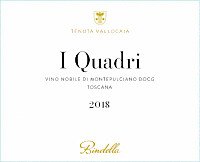
|
|
Vino Nobile di Montepulciano I Quadri 2018 |
|
| Bindella (Tuscany, Italy) | |
 Sangiovese Sangiovese | |
| Price: € 30.00 | Score: |
 Intense ruby red and nuances of ruby red, little transparency. Intense ruby red and nuances of ruby red, little transparency. Intense, clean, pleasing, refined and elegant, starts with hints of
black cherry, plum and violet followed by aromas of peony, geranium,
raspberry, blueberry, blackberry, chocolate, cinnamon, tobacco, leather,
pink pepper, mace, vanilla and menthol. Intense, clean, pleasing, refined and elegant, starts with hints of
black cherry, plum and violet followed by aromas of peony, geranium,
raspberry, blueberry, blackberry, chocolate, cinnamon, tobacco, leather,
pink pepper, mace, vanilla and menthol.
 Properly tannic attack and however balanced by alcohol, full body,
intense flavors, agreeable. Properly tannic attack and however balanced by alcohol, full body,
intense flavors, agreeable.
 Very persistent finish with long flavors of black cherry, plum and
raspberry. Very persistent finish with long flavors of black cherry, plum and
raspberry.
 20 months in cask, 12 months in bottle. 20 months in cask, 12 months in bottle. |
|
 Game, Roasted meat, Stewed and braised meat, Hard cheese Game, Roasted meat, Stewed and braised meat, Hard cheese |
|
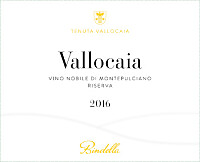
|
|
Vino Nobile di Montepulciano Riserva Vallocaia 2016 |
|
| Bindella (Tuscany, Italy) | |
 Sangiovese (90%), Colorino del Valdarno (10%) Sangiovese (90%), Colorino del Valdarno (10%) | |
| Price: € 35.00 | Score: |
 Intense ruby red and nuances of garnet red, little transparency. Intense ruby red and nuances of garnet red, little transparency. Intense, clean, pleasing, refined and elegant, starts with hints of
black cherry, plum and dried violet followed by aromas of dried rose,
peony, blueberry, raspberry, blackberry, cinnamon, cocoa, tobacco, face
powder, licorice, leather, mace, vanilla and menthol. Intense, clean, pleasing, refined and elegant, starts with hints of
black cherry, plum and dried violet followed by aromas of dried rose,
peony, blueberry, raspberry, blackberry, cinnamon, cocoa, tobacco, face
powder, licorice, leather, mace, vanilla and menthol.
 Properly tannic attack and however balanced by alcohol, full body,
intense flavors, pleasing roundness. Properly tannic attack and however balanced by alcohol, full body,
intense flavors, pleasing roundness.
 Very persistent finish with long flavors of black cherry, plum and
blueberry. Very persistent finish with long flavors of black cherry, plum and
blueberry.
 2 years in cask, 1 year in bottle. 2 years in cask, 1 year in bottle. |
|
 Game, Roasted meat, Stewed and braised meat, Hard cheese Game, Roasted meat, Stewed and braised meat, Hard cheese |
|
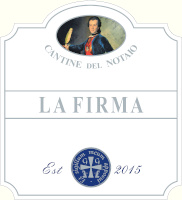
|
|
Aglianico del Vulture La Firma 2015 |
|
| Cantine del Notaio (Basilicata, Italy) | |
 Aglianico Aglianico | |
| Price: € 32.90 | Score: |
 Intense ruby red and nuances of garnet red, little transparency. Intense ruby red and nuances of garnet red, little transparency. Intense, clean, pleasing, refined and elegant, starts with hints of
black cherry, blackberry and plum followed by aromas of violet, blueberry,
raspberry, tobacco, cocoa, carob, cinnamon, licorice, leather, mace,
vanilla and menthol. Intense, clean, pleasing, refined and elegant, starts with hints of
black cherry, blackberry and plum followed by aromas of violet, blueberry,
raspberry, tobacco, cocoa, carob, cinnamon, licorice, leather, mace,
vanilla and menthol.
 Properly tannic attack and however balanced by alcohol, full body,
intense flavors, pleasing crispness. Properly tannic attack and however balanced by alcohol, full body,
intense flavors, pleasing crispness.
 Very persistent finish with long flavors of black cherry, blackberry
and plum. Very persistent finish with long flavors of black cherry, blackberry
and plum.
 12 months in cask, 12 months in bottle. 12 months in cask, 12 months in bottle. |
|
 Game, Roasted meat, Braised and stewed meat, Hard cheese Game, Roasted meat, Braised and stewed meat, Hard cheese |
|
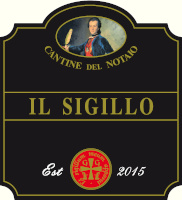
|
|
Aglianico del Vulture Il Sigillo 2015 |
|
| Cantine del Notaio (Basilicata, Italy) | |
 Aglianico Aglianico | |
| Price: € 36.30 | Score: |
 Deep ruby red and nuances of garnet red, little transparency. Deep ruby red and nuances of garnet red, little transparency. Intense, clean, pleasing, refined and elegant, starts with hints of
plum, black cherry and blackberry followed by aromas of dried violet,
blueberry, carob, tobacco, chocolate, cinnamon, face powder, mace, leather,
licorice, vanilla and menthol. Intense, clean, pleasing, refined and elegant, starts with hints of
plum, black cherry and blackberry followed by aromas of dried violet,
blueberry, carob, tobacco, chocolate, cinnamon, face powder, mace, leather,
licorice, vanilla and menthol.
 Properly tannic attack and however balanced by alcohol, full body,
intense flavors, agreeable. Properly tannic attack and however balanced by alcohol, full body,
intense flavors, agreeable.
 Very persistent finish with long flavors of black cherry, plum and
blackberry. Very persistent finish with long flavors of black cherry, plum and
blackberry.
 24 months in cask, 24 months in bottle. 24 months in cask, 24 months in bottle. |
|
 Game, Roasted meat, Braised and stewed meat, Hard cheese Game, Roasted meat, Braised and stewed meat, Hard cheese |
|

|
|
Frank! 2018 |
|
| Barollo (Veneto, Italy) | |
 Cabernet Franc Cabernet Franc | |
| Price: € 22.00 | Score: |
 Intense ruby red and nuances of garnet red, little transparency. Intense ruby red and nuances of garnet red, little transparency. Intense, clean, pleasing, refined and elegant, starts with hints of
black currant, black cherry and plum followed by aromas of dried violet,
blueberry, raspberry, bell pepper, chocolate, coffee, tobacco, tomato leaf,
cinnamon, face powder, vanilla and eucalyptus. Intense, clean, pleasing, refined and elegant, starts with hints of
black currant, black cherry and plum followed by aromas of dried violet,
blueberry, raspberry, bell pepper, chocolate, coffee, tobacco, tomato leaf,
cinnamon, face powder, vanilla and eucalyptus.
 Properly tannic attack and however balanced by alcohol, good body,
intense flavors, agreeable. Properly tannic attack and however balanced by alcohol, good body,
intense flavors, agreeable.
 Very persistent finish with long flavors of black currant, black cherry
and plum. Very persistent finish with long flavors of black currant, black cherry
and plum.
 14 months in barrique, 6 months in bottle. 14 months in barrique, 6 months in bottle. |
|
 Broiled meat and barbecue, Roasted meat, Stewed meat with mushrooms, Cheese Broiled meat and barbecue, Roasted meat, Stewed meat with mushrooms, Cheese |
|
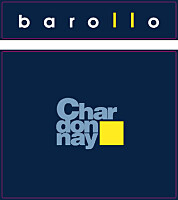
|
|
Venezia Chardonnay 2018 |
|
| Barollo (Veneto, Italy) | |
 Chardonnay Chardonnay | |
| Price: € 22.00 | Score: |
 Brilliant golden yellow and nuances of golden yellow, very transparent. Brilliant golden yellow and nuances of golden yellow, very transparent. Intense, clean, pleasing, refined and elegant, starts with hints of
banana, citron and acacia followed by aromas of hawthorn, apricot, apple,
pear, mango, papaya, plum, grapefruit, pineapple, praline, butter, honey,
flint and vanilla. Intense, clean, pleasing, refined and elegant, starts with hints of
banana, citron and acacia followed by aromas of hawthorn, apricot, apple,
pear, mango, papaya, plum, grapefruit, pineapple, praline, butter, honey,
flint and vanilla.
 Crisp attack and however balanced by alcohol, good body, intense
flavors, pleasing roundness. Crisp attack and however balanced by alcohol, good body, intense
flavors, pleasing roundness.
 Very persistent finish with long flavors of banana, citron and apricot. Very persistent finish with long flavors of banana, citron and apricot. 10 months in barrique, 6 months in bottle. 10 months in barrique, 6 months in bottle. |
|
 Stuffed pasta with fish, Roasted fish, Roasted white meat, Broiled crustaceans Stuffed pasta with fish, Roasted fish, Roasted white meat, Broiled crustaceans |
|
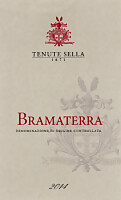
|
|
Bramaterra 2014 |
|
| Tenute Sella (Piedmont, Italy) | |
 Nebbiolo (70%), Croatina (20%), Vespolina (10%) Nebbiolo (70%), Croatina (20%), Vespolina (10%) | |
| Price: € 24.50 | Score: |
 Brilliant ruby red and nuances of orange red, moderate transparency. Brilliant ruby red and nuances of orange red, moderate transparency. Intense, clean, pleasing, refined and elegant, starts with hints of
cherry, plum and dried violet followed by aromas of dried rose, raspberry,
cinnamon, cocoa, leather, tobacco, licorice, rhubarb, vanilla and menthol. Intense, clean, pleasing, refined and elegant, starts with hints of
cherry, plum and dried violet followed by aromas of dried rose, raspberry,
cinnamon, cocoa, leather, tobacco, licorice, rhubarb, vanilla and menthol.
 Properly tannic attack and however balanced by alcohol, good body,
intense flavors, agreeable. Properly tannic attack and however balanced by alcohol, good body,
intense flavors, agreeable.
 Persistent finish with flavors of cherry, plum and raspberry. Persistent finish with flavors of cherry, plum and raspberry. 28 months in cask. 28 months in cask. |
|
 Broiled meat and barbecue, Roasted meat, Stewed meat with mushrooms, Cheese Broiled meat and barbecue, Roasted meat, Stewed meat with mushrooms, Cheese |
|
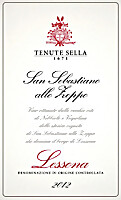
|
|
Lessona San Sebastiano allo Zoppo 2012 |
|
| Tenute Sella (Piedmont, Italy) | |
 Nebbiolo (85%), Vespolina (15%) Nebbiolo (85%), Vespolina (15%) | |
| Price: € 40.00 | Score: |
 Brilliant garnet red and nuances of red brick, little transparency. Brilliant garnet red and nuances of red brick, little transparency. Intense, clean, pleasing, refined and elegant, starts with hints of
cherry, plum and dried violet followed by aromas of dried rose, raspberry,
strawberry, cocoa, tobacco, cinnamon, leather, licorice, mace, undergrowth,
thyme, ginger, vanilla and menthol. Intense, clean, pleasing, refined and elegant, starts with hints of
cherry, plum and dried violet followed by aromas of dried rose, raspberry,
strawberry, cocoa, tobacco, cinnamon, leather, licorice, mace, undergrowth,
thyme, ginger, vanilla and menthol.
 Properly tannic attack and however balanced by alcohol, good body,
intense flavors, pleasing crispness. Properly tannic attack and however balanced by alcohol, good body,
intense flavors, pleasing crispness.
 Persistent finish with flavors of cherry, plum and raspberry. Persistent finish with flavors of cherry, plum and raspberry. 36 months in cask. 36 months in cask. |
|
 Roasted meat, Stewed and braised meat with mushrooms, Cheese Roasted meat, Stewed and braised meat with mushrooms, Cheese |
|
|
||||||||
|
DiWineTaste Polls
|
| |||||||
Privacy Policy | |||||||


| Copyright © 2002-2024 Antonello Biancalana, DiWineTaste - All rights reserved |
| All rights reserved under international copyright conventions. No part of this publication and of this WEB site may be
reproduced or utilized in any form or by any means, electronic or mechanical, without permission in writing from DiWineTaste. |